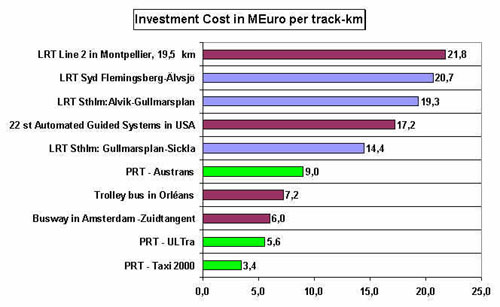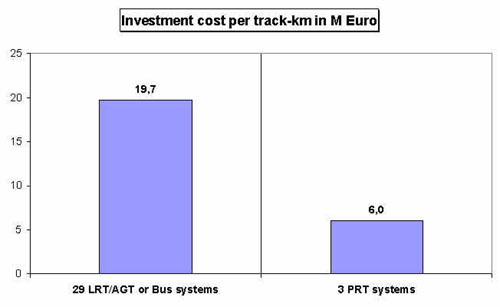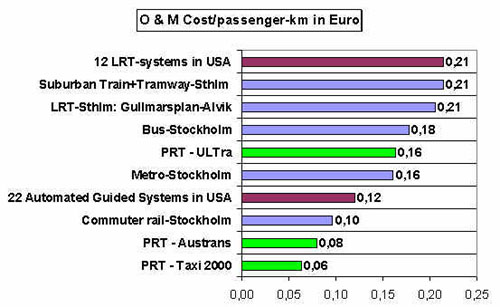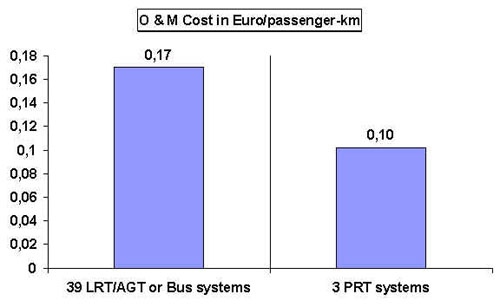
Comparison of Costs between Bus, PRT, LRT and Metro/rail
by Göran Tegnér
TRANSEK Consultants
This is a chapter from a forthcoming report for the project entitled European Demonstration of Innovative City Transport (EDICT)
General cost aspects
An important issue in marketing the idea of Personal Automated Transport is the relative cost advantages of PRT as compared to the more traditional modes of public transport such as bus, LRT, metro and commuter rail systems. This chapter forms a basis for a comprehensive cost-benefit analysis for and costs of a PRT system at Kungens Kurva, At Huddinge Municipal. There are two cost factors that are most relevant to compare, and they are:
Investment cost for track, vehicles and stations
Operating and Maintenance cost (O&M cost) for the entire system
A difficulty in comparing the cost components between systems, already existing, and PRT, as an almost entirely new mode of public transport system, is that the existing systems could benefit from some economics of scale, as buses, but also LRT vehicles and metro cars are produced since a long time ago, in rather long series, which ought to lead to falling unit costs. PRT – being a totally new transport mode – are more prototype like, with normally yields higher unit costs. On the other hand, there is risk that some forms of operating costs might be under-estimated, without a long time period of operating experiences. Thus, there is a certain degree of uncertainty as regards the true long terms costs for the PRT mode. This is almost impossible to overcome without a true real-world test period. This is therefore also a good argument to start implementing PRT test tracks in as many places as possible.
Cost comparisons between public transport modes - The Stockholm case
Among the traditional public transport modes, the following ones have been compared:
Bus
Light Rail Transit (LRT)
Metro
Commuter rail
with data from the Stockholm Region, completed with some international comparisons as well. The following PRT systems are included in the comparisons:
Ultra
Taxi 2000
Austrans
Investment costs – PRT three times cheaper than other systems
The total investment costs for guideway, vehicles and stations are compared to ten different systems:

Bars in blue colour are Stockholm systems, in green are PRT systems and in Brown are other systems. The Three Stockholm LRT systems costs around 15-20 M Euro per track-kilometer. The new LRT Line 2 in Montpellier costs approx. 22 M Euro per km. A summary of 22 Automated Guided systems in the US have an average cost of 17M Euro per track-km.
All three PRT systems show a lower investment cost than the studied LRT systems. With Austrans at 9 M€, ULTra at 5,6 M€ and Taxi 2000 at 3.4 M€ per kilometre. An average of the three PRT systems yields an investment cost of 6M€ per track-kilometre. This is the same cost as for the newly opened Zuidtangent Busway outside Amsterdam and even lower than the Trolley bus in Orléans, France.
The average investment costs for all the other systems (AGT, LRT and Busway/Trolleybus route) are more than three (3!) times higher than for the PRT system.
Conclusion: A Personal Rapid Transit system is three times cheaper than traditional Light Rail systems in investment cost.A simplified comparison between 29 various LRT/AGT or Bus systems (se page above) with the 3 PRT systems, show the following investment cost differences:

PRT is therefore a low-cost system from the investors point-of-view.
[Line 2 in Montpellier, 19.5 kms, 424 M€, opens in 2005; Orléans LRT: 22.7 kms, 34 stops, 25 vehicles; Source: Rail & Transport, 3rd July 2002 (Consultant: Semaly)]
Operating & Maintenance costs – PRT 40% cheaper
The operating cost experiences stem from the Greater Stockholm Transit Company; AB Stor-sStockholms Lokaltrafik, Annual Report 2001. The PRT Operating costs have been obtained from each supplier in January-February 2003. The American experiences are from the Trans 21 Database (Lawrence Fabian’s database). The following results are found:

As can be seen from the figure above, PRT systems perform very well also from the operating cost point-of-view. Most LRT-systems, both in the US and in Stockholm, cost around 0.20 Euro per passenger-kilometer and the bus network (9 153 km; 1 674 buses) in Stockholm costs 0.18 Euro/pass-km.
The ULTra PRT cost figure (calculated for the first phase network at Kungens Kurva) show a lower cost, 0.16 Euro per passenger-km, which is the same level as for the Stockholm Metro system (108 km; 800 metro-cars). The average operating costs for the 22 Automated Guided systems in USA cost 0.12 Euro per passenger-km and the Commuter rail network in Stockholm (186 km: 292 vehicles) cost 0.10 €/pass-km.
Both the Austrans and the Taxi 200 PRT systems are even cheaper in operation with 0.08 and 0.06 Euro per passenger-kilometer respectively.
An average of the three PRT systems yields an operating (and maintenance) cost of 0.10 Euro per passenger-kilometer. The average operating & maintenance costs for all the other systems (AGT/LRT; Bus, Metro and Commuter rail systems) are 70 % more expensive to operate than for the PRT system.
Conclusion: A Personal Rapid Transit system is more than 40 % cheaper than traditional Light Rail systems in operating costs.
The Operating & maintenance costs comparison is summarized in the figure below:

Traditional public transport systems such as bus, Light rail and Metro is about 70 % more expensive to operate than the new and innovative transit systems such as PRT. In Stockholm, only the commuter rail system has such low operating costs as PRT.
Last modified: August 29, 2003